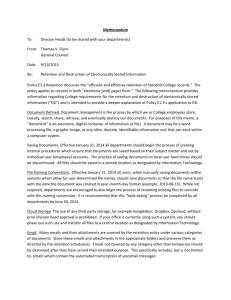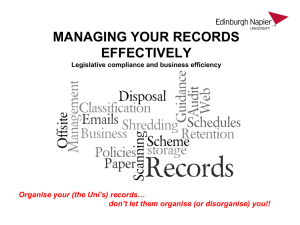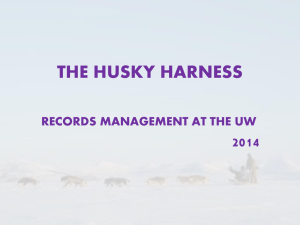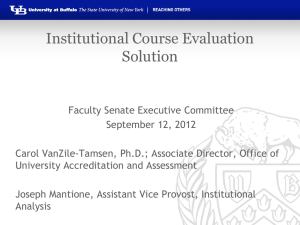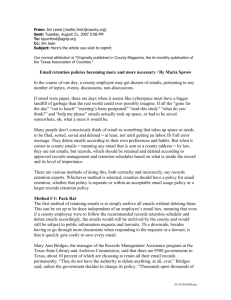Records Retention and Archival Policy (BU-PP 038)
advertisement
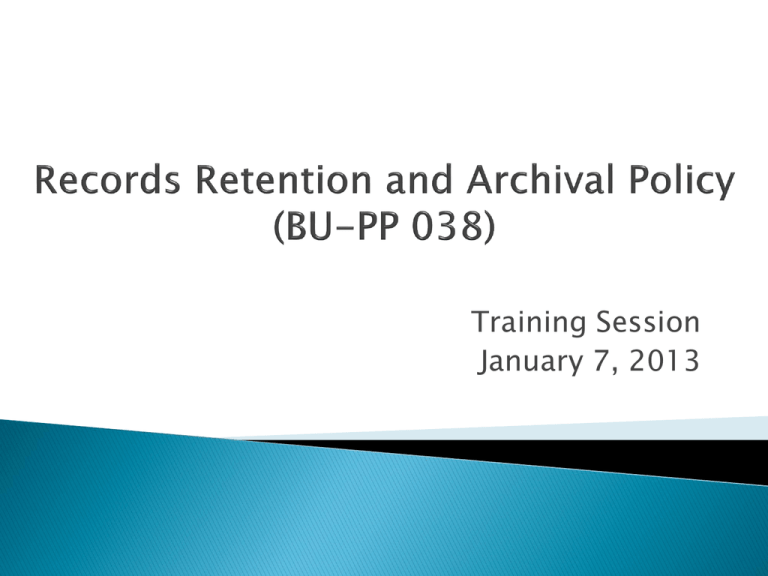
Training Session January 7, 2013 Background on the Policy (Juan) Policy Roll-out Process (Pattie) Records Management Self-Assessment (Amanda and John) Policy website and other sources for support (Juan) Next Steps (Juan) Regents Approved in February 2012 Purpose ◦ Identification ◦ Preservation ◦ Collection Benefits: ◦ Streamline storage costs ◦ Spend less time and money managing data ◦ Greater ease in finding important information ◦ Streamline response to litigation or investigations Committee Composition and Meetings Development of the Records Management Self-Assessment Overview ◦ What records do you have? ◦ Where are the records located? ◦ What records do you have to keep? ◦ How do digital records factor in to this? Financial—invoices, P-card, contracts HR—applications, personnel files, immigration documentation Faculty—tenure review notebooks, curriculum action, student disciplinary General—meeting records, reports, photos and AV materials, policies, office publications Other—what records are unique to your office? Paper or digital? Consider how both are kept (and security needs). Are records centrally managed or for each, his/her own? (physical files AND servers) Can you easily find records when you need them? Do you use off-site storage, microfilming, or imaging? Do you transfer records to the University Archives? Does your office keep records that are the primary responsibility of another office? (personnel files, invoices, etc.) Do other offices maintain records that ultimately are your responsibility? How do you know when to keep, transfer or destroy records? Record: recorded transactions of Baylor’s activities and affairs, in any format (including without limitation paper, electronic and audiovisual materials), both created and received by Baylor See Records Retention and Archival Policy and Common Record Guidelines—but each office should prepare its own retention policy to address its unique records Whatever retention needs apply to paper also apply to born-digital records ITS backups Regular backups do occur of systems like TRAX and BANNER Desktop computer backups—kept from 30 days of creation (especially important when handling employee exits) Exchange (email) server backups—kept from 14 days of creation Employees are ultimately responsible for their own recordkeeping practices Emails are records which may contain evidence of official University actions, decisions, approvals, or transactions. Most received and sent emails have a very temporary value—but some are very important. Preliminary drafts Routine replies/requests for information Emails sent as reference or for informational distribution* Emails used to schedule meetings Announcements* Acknowledgements *assuming this information is documented elsewhere Consult the Appendix to the Records Retention and Archival Policy and Common Records Guidelines. Also consider your office’s needs in retaining emails for reference as you prepare a retention schedule. Email records might include: ◦ Policy and procedure directives ◦ Instruction regarding the implementation of substantive decisions regarding matters of University business ◦ Legal or audit issues ◦ Approvals for purchases or other actions to be taken ◦ Final reports or recommendations ◦ Receipts for purchases made electronically How to keep email Retain electronically (preferred): Use Outlook’s Archive feature to save emails in local digital folders and retain searchability. The employee is responsible for ensuring that the email remains accessible (for all who need it) for the full retention period and that it is backed up. Print and file: Lose keyword search capability and ability to use links, possible loss of attachments or understanding of back-and-forth dialogue; can promote sharing with colleagues as necessary Consult with the University Archivist if you believe your office has emails that belong with the office’s records in the Baylor University Archives Website - http://www.baylor.edu/ia/ Training Sessions (Dates TBD) Internal Audit & Management Analysis ◦ 710-3867 ◦ Juan_Alejandro@Baylor.edu Keep a record of all your hardware & software (so you know how to access old file formats and such) Keep your records retention schedule current Be aware of electronic “footprints” – delete does not always mean delete (contact ITS for guidance) Stop any document destruction on receiving notice of any legal/audit action Implementation deadline Sources for assistance Internal Audits


